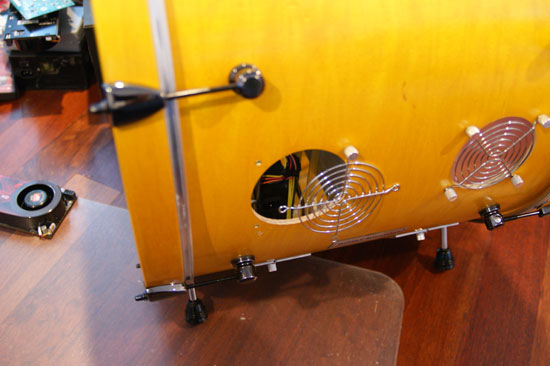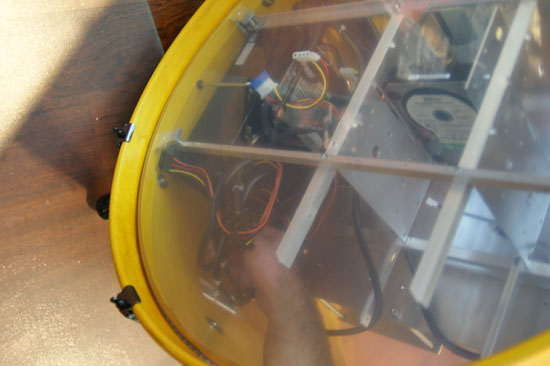Spotswood Custom Computer Cases
by Derek Wilson on August 27, 2008 12:00 AM EST- Posted in
- Cases/Cooling/PSUs
Notes on Cooling
This case isn't designed with conventional airflow in mind. Normally we want airflow directed in from the front and out of the back of a case, passing over the components inside. The main exhaust for this system is meant to be the top (which isn't a bad idea: heat does rise anyway), but the orientation of the board is wrong for optimal airflow over the components. Additional fan mounts are on the back and side, but there's no mount or intake on the front (though you can probably have one added by request). You can also reverse fan direction as you see fit, but you'll want to avoid creating extra turbulence so adding intake fans on the bottom makes the most sense.
In reality, this case is meant for water-cooling everything - and we mean everything. The system comes with mounting brackets to attach a radiator to the 120mm fans at the top exhaust port, offering quite a bit of airflow and room for a nice large radiator. This is a good design for a water-cooling system, and definitely the best way to go in terms of cooling the system inside.
It is possible to attach fans and radiators to the rear and bottom fan portals as well, but we would recommend adding an intake portal to at least one of the side panels if you plan to mount three internal radiators. Actually, leaving at least one of the rear fan portals free will help out a lot, as there is no easy way to reach the rear panel on the mobo, the PSU hard power switch, or any other cables going into the system from the back. Of course, if you leave one of these rear fan portals free, you can just take out three thumbscrews and reach right into the system to do whatever you need.


Our recommendation on cooling a system configured like ours (i.e. without water-cooling) is to use the bottom fan portals for intake (with intake fans) and use the top and rear for exhaust. The rear exhaust nearest the expansion slots on the mobo will be important if you are not water-cooling your graphics card, as you will want something to direct the air from the graphics card away from the rest of the system - normally, high-end GPUs vent directly out of the case, but this design prevents that. Water-cooling everything (including the graphics card(s)) with two radiators and intake fans on the bottom is probably the best option.
The one chink in the armor is that the PSU will still exhaust into the case in an area that is not near any fan portals and happens to be right under the hard drive array area. I've had more than one hard drive die via overheating, so I would look at adding some internal fans to move air around the drives as well. A solution might be a small exhaust portal on the front near the bottom
With an enthusiast system inside, properly cooled, this will not be a quiet computer. Of course, you could go another way and just attach an industrial fan to the front or back and create a wind tunnel across the system. Yeah, that might work...










36 Comments
View All Comments
Slash3 - Wednesday, August 27, 2008 - link
Sweet - it's like the horribly misguided and awkward first years of amateur case modding, made new again. And at exorbitant cost! Excellent. I can't wait to see what they come up with next. Perhaps an aquarium tank, coffee table or a large lamp shaped like a life-sized anime figure.CherryBOMB - Wednesday, August 27, 2008 - link
Nice.strafejumper - Wednesday, August 27, 2008 - link
skimmed thru looking for a pic of the finished system fully builtnot seeing one
strafejumper - Wednesday, August 27, 2008 - link
nm found onehttp://www.spotswoodcustomcomputers.com/gallery/Co...">http://www.spotswoodcustomcomputers.com/gallery/Co...
this is without monitor, mouse, keyboard, lan, sound, etc. hooked up. I'm thinking once you hook it up the wires may take away from the effect
crimson117 - Wednesday, August 27, 2008 - link
Wireless keyboard / mouse / networking.Monitor cable still an issue.
Googer - Wednesday, August 27, 2008 - link
Several Companies make adapters for wireless monitor connections. Though the problem with it is, you are transmitting potentially secure information that anyone could pick up and decode. Having a wireless monitor is like haveing someone peek over your shoulder while inputing a credit card number, password, or other sensitive information.http://www.engadget.com/2008/08/25/iogears-wireles...">http://www.engadget.com/2008/08/25/ioge...a-kit-ex...
Googer - Wednesday, August 27, 2008 - link
Amendment- Since DVI and HDMI use the same TDMS signal you could also get away with one of those wireless HDMI adapters.http://www.google.com/products?q=gefen+wireless+hd...">http://www.google.com/products?q=gefen+...=Search+...
http://www.engadget.com/2007/06/20/gefen-goes-wild...">http://www.engadget.com/2007/06/20/gefe...d-extend...
Googer - Wednesday, August 27, 2008 - link
http://www.gefen.com/kvm/dproduct.jsp?prod_id=4318">http://www.gefen.com/kvm/dproduct.jsp?prod_id=4318JarredWalton - Wednesday, August 27, 2008 - link
Check the gallery for the system build. There aren't pictures of the system connected to monitor and keyboard and such, but the rest is there.Pyrokinetic - Wednesday, August 27, 2008 - link
Wow...really different, but not in the cool way. That is just ugly. But, when you gotta keep the homelife happy...That case is prime example why every guy needs an office/den. She can do whatever else to the rest of the house...